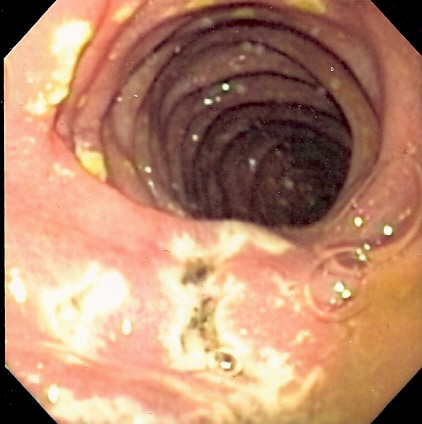Zollinger-Ellison syndrome (patient information)
For the WikiDoc page for this topic, click here
| Zollinger-Ellison syndrome (patient information) | |
 | |
|---|---|
| Endoscopy image of multiple small ulcers in the distal duodenum in a patient with Zollinger-Ellison syndrome | |
| ICD-10 | E16.4 |
| ICD-9 | 251.5 |
| MedlinePlus | 000325 |
| eMedicine | med/2437 ped/2472 |
| MeSH | D015043 |
| Gastrinoma | |
 | |
|---|---|
| Pancreatic gastrinoma. As shown in this electron microscopic image, tumor cells contain typical vesicular G-cell granules as well as nondiagnostic dense granules (X28.000). Image courtesy of Professor Peter Anderson DVM PhD and published with permission © PEIR, University of Alabama at Birmingham, Department of Pathology | |
| ICD-O: | 8153 |
| DiseasesDB | 14279 |
| eMedicine | med/2678 |
| MeSH | D015408 |
Editor-In-Chief: C. Michael Gibson, M.S., M.D. [1]; Jinhui Wu, MD
Please Join in Editing This Page and Apply to be an Editor-In-Chief for this topic: There can be one or more than one Editor-In-Chief. You may also apply to be an Associate Editor-In-Chief of one of the subtopics below. Please mail us [2] to indicate your interest in serving either as an Editor-In-Chief of the entire topic or as an Associate Editor-In-Chief for a subtopic. Please be sure to attach your CV and or biographical sketch.
What is Zollinger-Ellison syndrome?
Zollinger-Ellison syndrome is also called gastrinoma. It is a rare disease characterized by one or more tumors in the pancreas, duodenum, or both. The tumors can cause the stomach to produce too much gastric acid, leading to peptic ulcers in the duodenum. Sometimes the tumors are cancerous and may spread to distant organs. Usual symptoms include burning abdominal pain, nausea and vomiting, weight loss and diarrhea. Treatmens include proton pump inhibitors and surgery.
How do I know if I have Zollinger-Ellison syndrome and what are the symptoms of Zollinger-Ellison syndrome?
Usual syptoms include:
- Burning in abdomen
- Nausea and vomiting
- Weight loss
- Diarrhea
Other health problems may also cause these symptoms. Only a doctor can tell for sure. A person with any of these symptoms should tell the doctor so that the problems can be diagnosed and treated as early as possible.
Who is at risk for Zollinger-Ellison syndrome?
There is no specific known risk factor that is responsible for Zollinger-Ellison syndrome.
How to know you have Zollinger-Ellison syndrome?
- Gastric acid level and the amount of gastrin circulating in the blood
- Upper gastrointestinal (GI) endoscopy: During this procedure, the doctor uses a thin, flexible, lighted tube with a small camera on the tip to see inside the upper GI tract.
- Somatostatin receptor scintigraphy (SRS): In this test, tumor cells can light up after the radiotracer is injected into the bloodstream. The signal can be scaned by the gamma camera.
- A computerized tomography (CT) scan: CT scans are often used to diagnose Zollinger-Ellison syndrome. It can confirm the location of the cancer, as well as distant organs where the cancer might have spread.
When to seek urgent medical care?
Call your health care provider if symptoms of Zollinger-Ellison syndrome develop. If you experience either of the following symptoms, seeking urgent medical care as soon as possible:
Treatment options
The treatments include medications to relieve ulcer symptoms, surgery to remove tumors and chemotherapy. Before treatment starts, ask your health care team about possible side effects and how treatment may change your normal activities.
- Proton pump inhibitors (PPI): This kind of drugs can effectively reduce gastric acid secretion in the stomach. Usual drugs include esomeprazole (Nexium), lansoprazole (Prevacid), pantoprazole (Protonix) and omeprazole (Prilosec).
- Surgery: Surgical removal of gastrinomas is the only cure for Zollinger-Ellison syndrome.
- Chemotherapy: For those the tumor can not be surgically removed, chemotherapy is available. The drugs include streptozotocin (Zanosar), 5-fluorouracil (Adrucil) and doxorubicin (Doxil).
Diseases with similar symptoms
Where to find medical care for Zollinger-Ellison syndrome?
Directions to Hospitals Treating Zollinger-Ellison syndrome
Prevention of Zollinger-Ellison syndrome
As a rare disease, the cause of Zollinger-Ellison syndrome is not clear. And the preventive measure is not known.
What to expect (Outook/Prognosis)?
The outcome for patients with Zollinger-Ellison syndrome largely depends on the nature and extent of the disease.
Copyleft Sources
http://www.nlm.nih.gov/medlineplus/ency/article/000325.htm